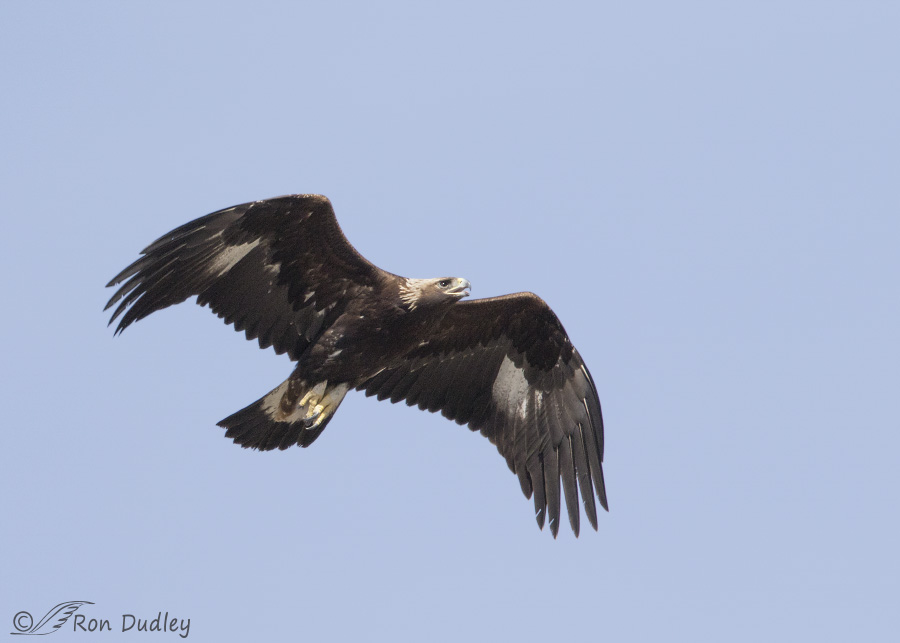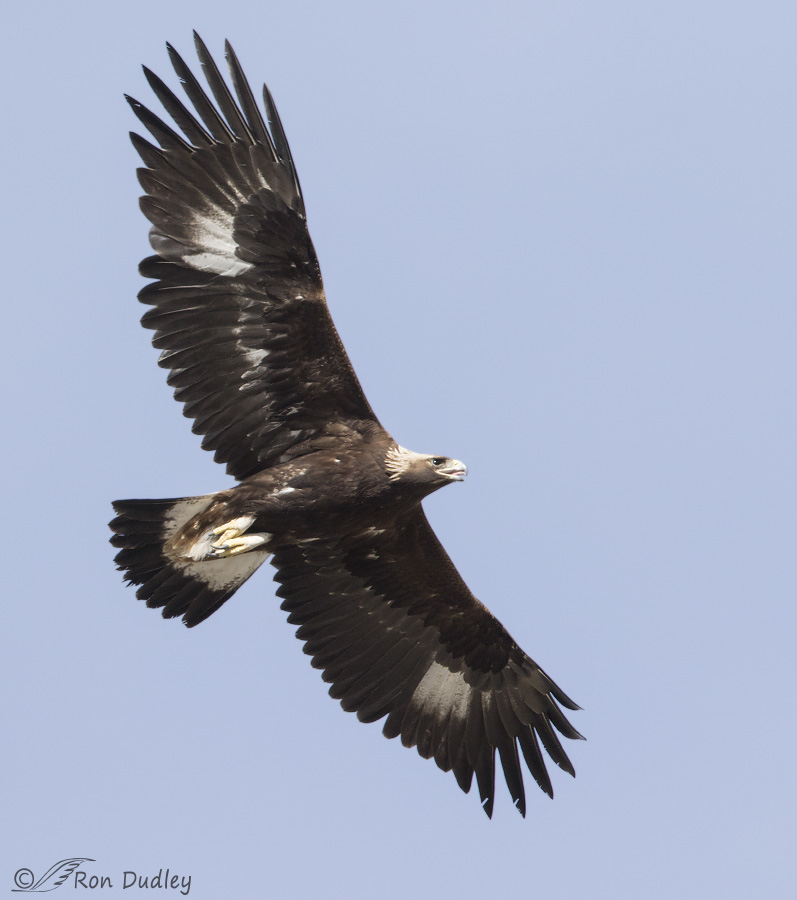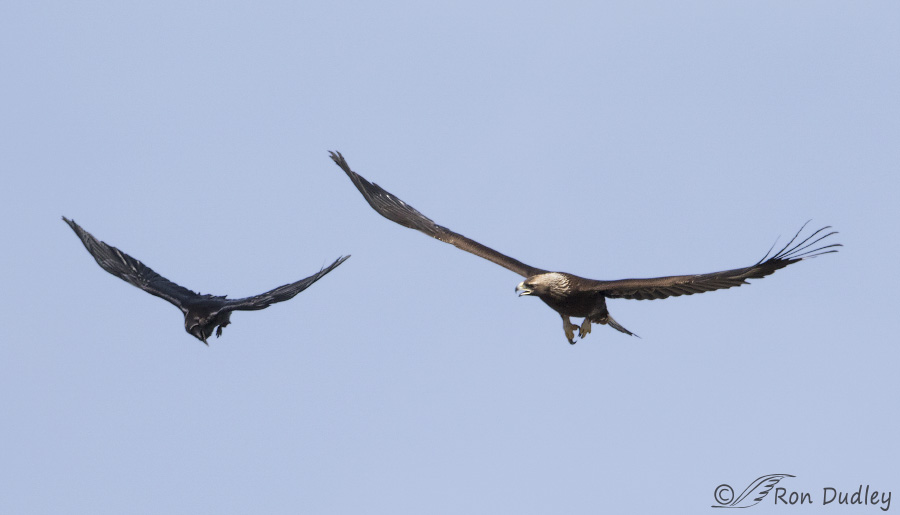This is a perspective on a Golden Eagle that’s new to my blog.
Over the years I’ve posted a fair number of Golden Eagle photos where the bird is either perched or has recently taken off. But this may be the first time I’ve included images of them flying high overhead.
1/2500, f/7.1, ISO 500, Canon 7D Mark II, Canon EF 500mm f/4L IS II USM + EF 1.4 III Extender, not baited, set up or called in
I photographed this juvenile three days ago in Box Elder County. These shots were taken late in the morning and overhead shots of raptors taken that time of day generally don’t appeal to me because their underside is deeply shaded with little detail. But on this day I had a little better detail there than usual so I thought these images were worth posting.
1/1250, f/7.1, ISO 500, Canon 7D Mark II, Canon EF 500mm f/4L IS II USM + EF 1.4 III Extender, not baited, set up or called in
This photo clearly shows the distinctive white wing patches and tail base of the juvenile. Those “bulging secondaries” are also unique to the first year bird. The wingspan of this species can be up to 7.5′ and that incredible length combined with the bulging secondaries must give juvenile Golden Eagles an absolutely amazing total wing surface area – one reason they can soar effortlessly for hours.
I took 136 photos of this bird and it had its beak open in nearly every one of them. I’m not sure why it was open in the beginning of the session but later on it may have been its reaction to an intruder.
1/3200, f/7.1, ISO 500, Canon 7D Mark II, Canon EF 500mm f/4L IS II USM + EF 1.4 III Extender, not baited, set up or called in
This Common Raven (and a second one to a lesser degree) persistently harassed the eagle and the larger bird wasn’t happy about it. I never heard the eagle screaming but perhaps the open beak was a threat. Eventually the eagle was driven off.
Perhaps one day I’ll get frame filling shots of a Golden Eagle in flight in the early morning so there’s better light under the wings. The chances for that are low however because the thermals they soar on don’t build up until later in the day when it warms up.
Ron





How majestic!
Oops. I am working with one eye and have double vision. Have what they call Third optic nerve palsy, and the condition should last from 3 to 6 months. One month down and it is a bummer. Hard to type and spell my words out also. It will get better!
Geez, that sounds terribly annoying, Trudy – to say the least! I love your positive attitude about it. I’ve never heard of a “third” optic nerve – thought there was only two of them. Now I’m curious enough about it to go digging…
Hang in there!
Just looking at these images again…the second just can’t be beat…it’s absolutely perfect!,,
Thank you, Patty.
That’s the kind of photo you want to fasten to your ceiling!!! I’d fasten it to mine in a heartbeat!!!
Ron, my first post did not go thru this morning. Just wanted to say you have some wonderful pictures of the Golden Eagle. Love them. Fly like an Eagle!!
Thanks, Trudy. Your first post did go through. It’s there below.
Nice shots Ron. Ravens can be pests lol. It amazes me they will take on a bird so much bigger, but they do. We see them harass the Red Tails here all the time. The only time I saws a Red Tail go after a Raven was due to the Raven stealing the Hawks Rabbit. I never saw a Raven fly away so fast lol.
Thank you, Jean.
Oh. My. Oh my, oh my, oh my.
Thank you.
Ah Goldens…sigh! Next to redtails and HHs, Goldens are my favorite. In the last photo, note that the eagle’s talons aren’t quite tucked for flight. Perhaps a warning signal that if the raven gets any closer, mayhem could ensue?
Good eye about the talons, Laura. But then I’d expect that of you.
Ron, they are so great, the pictures and the Eagles! You just make every ones day so happy. Oh to fly like an Eagle! Love them.
Thanks, Trudy – for the compliment and for the song that’s now going through my head!
OH, BOY!!!! Whatever happened to the “nemesis” theory????? These are spectacular shots!!! LOVE the second–don’t see how it could be better- shows all the detail that make the juveniles so special…Wambli gleska! Also really like the first…with the eagle cussing out the raven…TWO of my favorite birds in the same frame…I’m happy!!!
Patty, a nemesis is meant to be conquered!
Ron, are you out of your truck when taking overheads like this? If so, you are shooting at an effective focal length of 1120 mm sans support? Impressive to not only keep the bird in the frame, but keep it all relatively stable. Great work!
Frank, No, I was in my truck but the bird was so high that sometimes I had to handhold through the window instead of taking the time to adjust my window and noodle (lens rest). Can’t remember which was the case here.
Really liked this. Nice to see the white so clearly.
Thanks, Arwen.
Having my first cup and get another post from you, and a special one at that. Love the big raptors and wish I had more opportunities. Tough exposures, sky + 2?. Maybe fill flash, just joking. Good buffer in that 7dII, eh? As you can perhaps tell, I have barely woken up. But I get to wake up w/ a smile. Great post Ron, thank you.
Frank, I was only +1 on these shots because I didn’t want to make the sky too bright. As a result I had to bring up the shadows during processing.
Yes, that Mark II buffer is a significant improvement over that of the 7D.
Beautiful! Soaring mid-day is generally not good for underside detail – I’ve been disappointed many times with that besides them being so far away! They can/do sit for long periods of time making flight photo’s a challenge to get patience not being my long suite!
They can/do sit for long periods of time making flight photo’s a challenge to get patience not being my long suite!  Ravens/Crows/Magpies/Orioles all harass them here regularly. Love the “conversation” between the birds in the last photo.
Ravens/Crows/Magpies/Orioles all harass them here regularly. Love the “conversation” between the birds in the last photo. 
Judy, whenever I see soaring eagles it seems like they’re being harassed much of the time. I’ve heard of documented cases where a raptor will snatch its tormentor right out of the sky so it must be done with finesse!
To me that second shot is out of this world! I would be in seventh heaven if I had shot that one.
Beautiful shots! That second shot has particular interest in the condition of the under-wing coverts.
Thanks, Dick. Agree about the coverts, especially on the right wing.
Great images Ron of the underside of these “photon sponges”. I find it so hard to get the exposure correct on the Golden Eagles. I like the last one where you see it communicating with the Raven
I agree, Ed – it’s usually very difficult. I wish they did more soaring in the early morning. Sometimes if there’s snow on the ground reflected light from the snow can help significantly.
Fantastic series Ron! Thanks for sharing!
Charlotte
Thank you, Charlotte.
Wow! Absolutely gorgeous! The second shot is magnificent! (And shows his cute little pink tongue — kind of reminds me of the way Charles Shulz used to show effort or concentration in his characters.)
And for bird neophytes like me, could you describe “bulging secondaries?” I’m not sure what you mean. Thanks! (I did, however, correctly ID his juvenile status from the white patches, so I am learning.).
Oh, and I wouldn’t try to dissuade you from sharing more of those 136 pictures.
Thanks, Marty. The secondaries of the wings of juveniles are longer than those of 2nd year birds or adults so they form a noticeable “bulge” on the the trailing wing edge, especially at about mid-wing.
Wow, you’re up early!
The joys –NOT! — of insomnia. But at least I got to see my favorite raptor!
But at least I got to see my favorite raptor! 